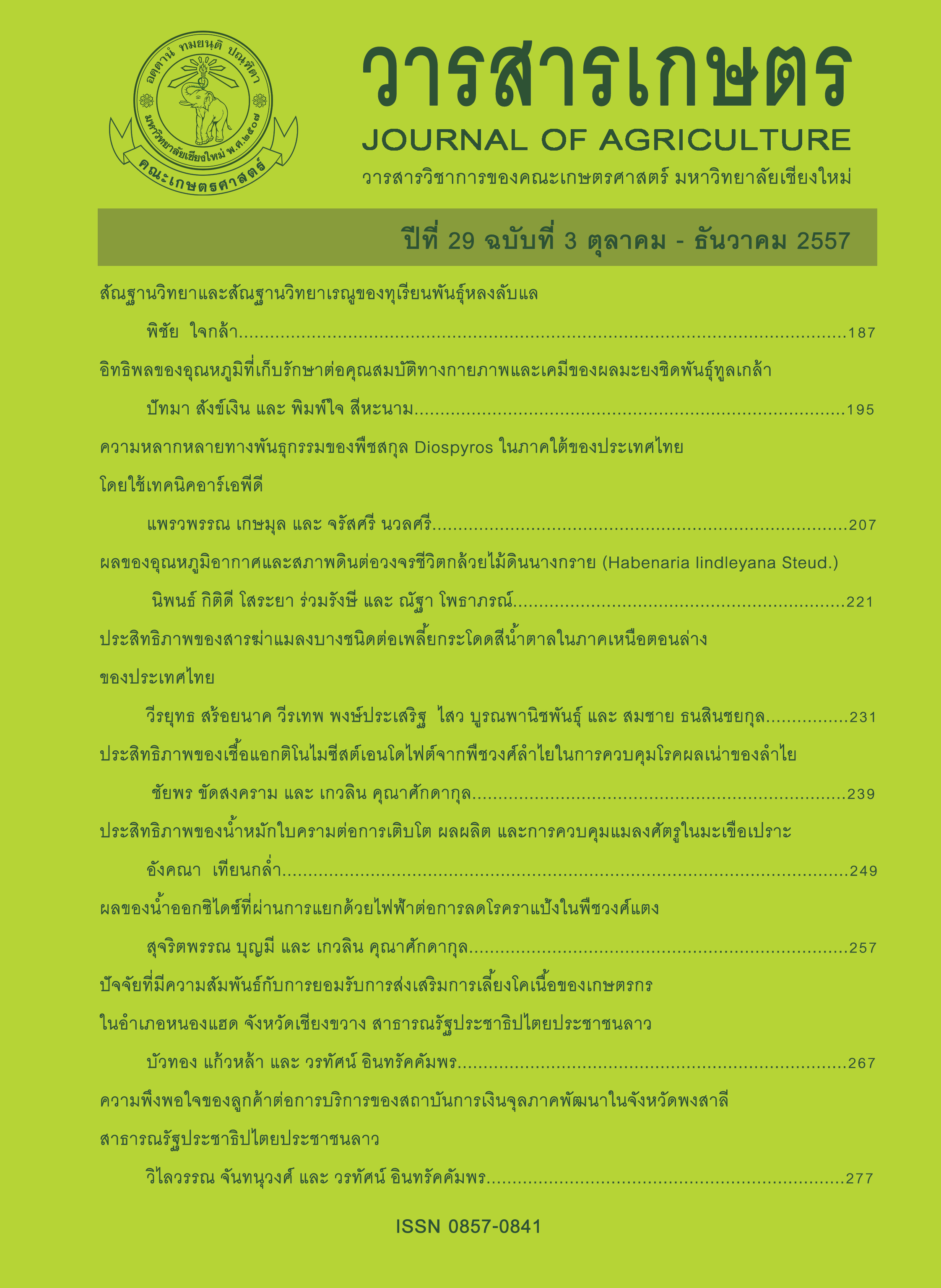ผลของน้ำออกซิไดซ์ที่ผ่านการแยกด้วยไฟฟ้าต่อการลดโรคราแป้งในพืชวงศ์แตง
Main Article Content
บทคัดย่อ
วัตถุประสงค์ในการศึกษาครั้งนี้ เพื่อตรวจสอบผลของน้ำออกซิไดซ์ที่ผ่านการแยกด้วยไฟฟ้า (electrolyzed oxidizing water: น้ำ EO) ต่อการงอกของ conidia และการลดโรคราแป้งที่เกิดจากเชื้อรา Fibroidium sp. ของพืชวงศ์แตง (แตงกวาญี่ปุ่น) โดยเตรียมเชื้อราแป้งจากการเก็บ colony ของเชื้อราจากพืชที่เป็นโรคในสภาพธรรมชาติ แล้วนำเชื้อไปปลูกบนต้นกล้าแตงกวาญี่ปุ่นที่เพาะเลี้ยงในห้องปฏิบัติการ และเตรียมน้ำ EO โดยใช้เครื่องผลิตน้ำออกซิไดซ์ Super Oxseed Labo (wonder BJ F850) จากสารละลาย NaCl ความเข้มข้น 0.05, 0.1, 0.2, 0.3, 0.4 และ 0.5 เปอร์เซ็นต์ ซึ่งพบว่าน้ำ EO ที่ผลิตได้มีค่า pH อยู่ในช่วง 3.71-3.93 และมีค่า electrolyte conductivity (EC) อยู่ระหว่าง 1.81-4.13 mS/cm เมื่อวัดค่าคลอรีนอิสระ (available free chlorine) ด้วยวิธี N, N-diethyl-p-phenylenediamine (DPD) พบมีค่าอยู่ในช่วง 18.7-165 ppm จากการทดสอบการยับยั้งการงอกของ conidia ด้วยการพ่นน้ำ EO ลงบน conidia ของเชื้อราแป้งที่ติดบนชิ้นวุ้น และบ่มเชื้อไว้ที่อุณหภูมิ 25 องศาเซลเซียส เป็นเวลา 12 และ 24 ชั่วโมง พบว่าน้ำ EO ความเข้มข้น 0.1-0.5 เปอร์เซ็นต์ มีผลยับยั้งการงอกของ conidia ได้ 100 เปอร์เซ็นต์ ขณะที่ความเข้มข้น 0.05 เปอร์เซ็นต์ และชุดควบคุม (น้ำกลั่นฆ่าเชื้อ) พบความงอกของ conidia เท่ากับ 67.78 และ 71.11 เปอร์เซ็นต์ ตามลำดับ แต่อย่างไรก็ตามการทดสอบความเป็นพิษของน้ำ EO ที่มีต่อพืช พบว่าที่ความเข้มข้น 0.4 และ 0.5 เปอร์เซ็นต์ ทำให้พืชเกิดอาการยอดไหม้ หลังจากพ่น 3 วัน สำหรับการลดโรคราแป้งบนแตงกวาญี่ปุ่นในสภาพโรงเรือน พบว่าเมื่อพ่นด้วยน้ำ EO ความเข้มข้น 0.3 เปอร์เซ็นต์ สามารถควบคุมการเกิดโรคได้ดีที่สุด ซึ่งสามารถลดอัตราการเกิดโรคได้ 29.70 เปอร์เซ็นต์ และทำให้การขยายขนาดของ colony เชื้อราแป้งลดลง อีกทั้งพบการยุบตัวของเส้นใยและ conidiophore นอกจากนี้ยังพบว่าความหนาแน่นของ conidia ต่อ colony ในทุกความเข้มข้นของน้ำ EO มีจำนวนลดลงแตกต่างอย่างมีนัยสำคัญทางสถิติเมื่อเปรียบเทียบกับชุดควบคุม (น้ำกลั่น)
Article Details
เอกสารอ้างอิง
อัญชัญ ชมพูพวง อังสนา อัครพิศาล วีณัน บัณฑิตย์ และ ณัฐา โพธาภรณ์. 2555. การตรวจสอบลูกผสมถั่วลันเตาที่ต้านทานโรคราแป้ง โดยการใช้เครื่องหมายดีเอ็นเอ. วารสารเกษตร 28(2): 155-163.
Abbasi, P. A. and G. Lazarovits. 2006. Effect of acidic electrolyzed water on the viability of bacterial and fungal plant pathogens and on bacterial spot disease of tomato. Canadian Journal of Microbiology 52: 915-923.
Acher, A., E. Fischer, R. Turnheim and Y. Manor. 1997. Ecologically friendly wastewater disinfection techniques. Journal of Water Research 31(6): 1398-1404.
Al-Haq, M. I., J. Sujiyama and S. Isobe. 2005. Applications of electrolyzed water in agriculture and food industries. Food Science and Technology Research 11(2): 135-150.
Bari, M. L., Y. Sabina, S. Isobe, T. Uemura and K. Isshiki. 2003. Effectiveness of electrolyzed acidic water in killing Escherichia coli O157 : H7, Salmonella enteritidis, and Listeria monocytogenes on the surfaces of tomatoes. Journal of Food Protection 66(4): 542-548.
Capuzzo, J. M. 1979. The effect of temperature on the toxicity of chlorinated cooling waters to marine animals A preliminary review. Marine Pollution Bulletin. Volume 10: 45-47.
Cook R. T. and U. Braun. 2009. Conidial germination patterns in powdery mildews. Mycological Research 113(5): 616-36.
Fujiwara, K., R. Doi, M. Iimoto and A. Yano. 2000. Fundamental studies on crop disease control by spraying electrolyzed anode-side water, 3: Effects of spraying electrolyzed anode-side water and pH available chlorine concentration-regulated water on the severity of powdery mildew infection and percentage of leaves with a leaf burn-like physiological disorder on cucumber leaves. Environmental Control in Biology 38: 33-38.
Fujiwara, K., T. Fujii and J. S. Park. 2009. Comparison of foliar spray efficacy of electrolytically ozonated water and acidic electrolyzed oxidizing water for controlling powdery mildew infection on cucumber leaves. Journal of the International Ozone Association 31: 10-14.
Fujiwara, K., T. Fujii and J. S. Park. 2011. Successive spraying efficacy of acidic electrolyzed oxidizing water and alkalic electrolyzed reducing water on controlling powdery mildew infection and suppressing visible physiological disorder on cucumber leaves. Journal of Horticultural Science and Biotechnology 52(4): 387-392.
Guentzel, J. L., M. A. Callan, K. L. Lam, S. A. Emmons and V. L. Dunham. 2011. Evaluation of electrolyzed oxidizing water for phytotoxic effects and pre-harvest management of gray mold disease on strawberry plants. Crop Protection 30: 1274-1279.
Huang, Y. R., H. S. Hsieh, S. Y. Lin, S. J. Lin, Y. C. Hung and D. F. Hwang. 2006. Application of electrolyzed oxidizing water on the reduction of bacterial contamination for seafood. Food Control 17: 987-993.
Jammaree, K., W. Kumpoun and K. Kunasakdakul. 2012. Effects of electrolyzed oxidizing water on reduction of anthracnose disease on fruit of mango cv. Nam Dok Mai. pp. 277-281. In: Proceedings: 1st ASEAN Plus Graduate Research Congress. Chiang Mai, Thailand.
Kuzuya, M., K. Hosoya, K. Yashiro, K. Tomita and H. Ezura. 2003. Powdery mildew (Sphaerotheca fuliginea) resistance in melon is selectable at the haploid level. Journal of Experimental Botany 54(384): 1069-1074.
Lee, Y. H., K. H. Cha, S. J. Ko, I. J. Park, B. I. Park and K. Y. Seong. 2000. Evaluation of electrolyzed oxidizing water as a control agent of cucumber powdery mildew. Journal of Plant Pathology 16(4): 206-210.
Nave, C. R. 2013. Acid-Base Reactions. (Online). Department of Physids and Astronomy. Available: http://hyperphysics.phy-astr.gsu. edu/ hbase/hframe.html (July 22, 2013).
Shun, Y. H. 2004. Effects of flow rate, temperature and salt concentration on chemical and physical properties of electrolyzed oxidizing water. Journal of Food Engineering 66: 171-176.
Sumida, O. 1998. Redox water and usage of oxidized water using redox water maker. Fresh Food System 26: 21-28.


